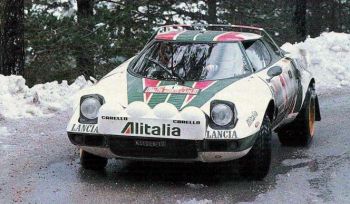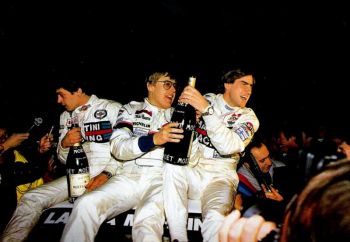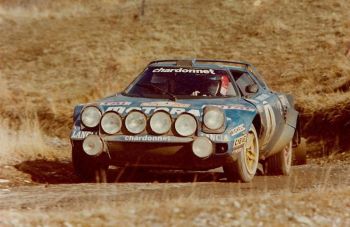 |
|
Lancia made the
Monte Carlo Rally its own in the 1970s with four wins for Sando Munari – in
1972 the legendary Italian claimed an unlikely victory in the Fulvia HF and then
three consecutive wins (1975-77) came behind the wheel of the immortal Stratos
(above). |
|
|
|
 |
|
Miki Biasion got the Group A
chapter underway with victory at
the wheel of the Lancia Delta HF 4WD, the first of four consecutive wins for the
car (the later triumphs coming in the car’s Integrale iterations). |
|
|
|
 |
|
Henri Toivonen triumphed on the Monte Carlo
Rally just as the Group B era came to a
close, his win marking his last triumph before his
untimely death in Corsica four months later. |
|
|
|
 |
|
Lancia won the
Monte Carlo Rally no less than five times
during the Group A era: in 1987, 1988, 1989,
1990 and 1992. Here Bruno Saby races to
victory at the wheel of the Delta Integrale
in 1988. |
|
|
|
 |
|
In 1979 Bernard
Darniche made it four wins for the Lancia Stratos that decade on the Monte Carlo
Rally, after winning by the slimmest of
margins. |
|
|
|
|
|
No other
event in the world conjures up the same level of
heritage, challenge and spectacle as the Monte Carlo
Rally. Run for the first time in 1911, it remains one of
the most renowned tests of man and machine the sport
offers. On January 21, the event will form the opening
round of the Intercontinental Rally Challenge, the first
time the legendary rally has been included on the IRC
schedule.
And with a three
strong factory-run Grande Punto S2000 line-up, plus the back
up support of a
quartet of private entries, the Abarth brand is seeking to stamp its name into
the record books for the first time, and join its Italian Fiat Group stable mates on the
famous
roll call of the world's most important rally: Fiat and Lancia have both
triumphed on the finish line in Monte Carlo.
Fiat's first
victory came back in 1928 courtesy of
Jacques Bignan, while Lancia took its first win in 1954 thanks to Louis Chiron.
Lancia really made the event its own in the 1970s with four superb wins for Sandro Munari – in
1972 the legendary Italian driver claimed an unlikely victory in the Fulvia HF, and then
three consecutive wins (1975-77) came behind the wheel of the immortal Stratos,
a car that simply rewrote the concept of the winning rally car. In 1979 Bernard
Darniche made it four wins for the Stratos that decade, before Walter Röhrl
kicked the 1980s off with a win for the Fiat 131.
Three years later in the
early era
of the fearsome Group B cars, Röhrl took a win at the wheel of the Lancia 037
Rally and the late Henri Toivonen rounding out the era with a win in its
successor, the dramatic Delta
S4 in 1986. A year later Miki Biasion got the Group A chapter underway with
victory at
the wheel of the Lancia Delta HF 4WD, the first of four consecutive wins for the
car (the later triumphs coming in the car’s Integrale iterations).
Winning the
glamorous Monte Carlo Rally along the way to a hatful of FIA
World Rally Championship titles helped cement Lancia's image
as one of the world's most evocative automotive brands. The winning
spree by Lancia
continued into the nineties with Frenchman Didier Auriol claiming victory in 1990 and
then again two years later (1992), leaving a seventeen-year gap until this
year before an Italian brand once
again pitches for victory.
Traditionally held in mid-January the rally is often
prone to inclement weather conditions, with snow and ice
frequently coating the mountainous asphalt passes and
leaving them extremely treacherous. As well as coping
with slippery stage surfaces, drivers must also
negotiate sharp hairpin turns, surrounded only by
perilously steep drops.
The event’s format has chopped and changed over time. Up
until 1991, competitors could select different starting
points prior to completing concentration runs in order
to reach the official starting location. In recent years
the rally mainly used stages in the Alpes Maritime
before switching to the Ardèche region in 2007, when
night stages – including a pass over the famous Col de
Turini – returned to the itinerary.
This year’s competition represents a major departure
from recent seasons with the rally starting in Monte
Carlo on Tuesday and then returning there for the finish on
Saturday.
Since 1973 the event has marked the opening round of the
FIA World Rally Championship, a year when Frenchman Jean-Claude Andruet claimed victory at the wheel of a Alpine-Renault
A110. After the global oil crisis forced the event’s
cancellation in 1974, Lancia's Munari began his
incredible run of three successive victories.
Following Jean-Pierre Nicolas’ success in 1978 (who is
now the IRC’s motorsport development manager), Darniche
triumphed on the 1979 event with a meagre
six-second advantage over Björn Waldegård’s Ford Escort
Mk II. Waldegård has always been convinced he would have won but for
the time lost when a group of unruly spectators blocked
a bridge with a lump of concrete.
Walter Röhrl’s third victory in 1983 (037 Rally) was the first
to be achieved by a rally car conforming to the Group B regulations,
and the German brought home his thunderous Audi Quattro in first place
a year later for his fourth win. Finns Ari Vatanen (1985) and Toivonen
(1986) also triumphed during the Group B era, Toivonen’s win marking his last triumph before his
untimely death on the Tour de Corsica just four months later.
Biaison helped to usher in the new Group A
regulations for 1987, when he claimed the first of two
victories. The Nineties coincided with Didier Auriol
taking four wins and Patrick Bernardini becoming an
unlikely victory in 1996 when the event counted towards
two-litre championship points only. Piero Liatti scored
the first win by a World Rally Car when he triumphed in
1997.
With World Rally Cars not permitted to take part on IRC
events, the 77th running of the rally will mark the
start of a fresh era for this famous event, with several
exciting new cars and drivers.
|